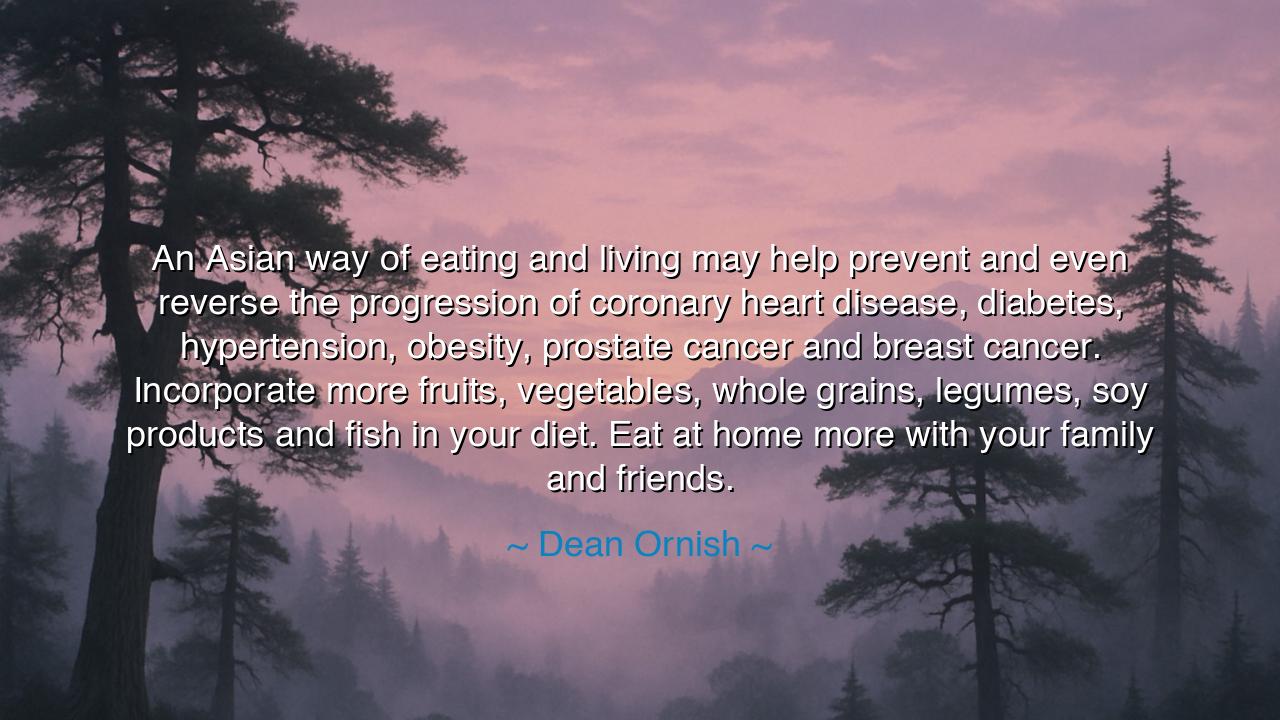
An Asian way of eating and living may help prevent and even
An Asian way of eating and living may help prevent and even reverse the progression of coronary heart disease, diabetes, hypertension, obesity, prostate cancer and breast cancer. Incorporate more fruits, vegetables, whole grains, legumes, soy products and fish in your diet. Eat at home more with your family and friends.






When Dean Ornish declared, “An Asian way of eating and living may help prevent and even reverse the progression of coronary heart disease, diabetes, hypertension, obesity, prostate cancer and breast cancer. Incorporate more fruits, vegetables, whole grains, legumes, soy products and fish in your diet. Eat at home more with your family and friends,” he was not merely giving dietary advice — he was reviving an ancient philosophy, one rooted in balance, community, and harmony with nature. His words call us back to a truth that humanity once knew instinctively: that health is not found in isolation or indulgence, but in a life lived in rhythm with the earth and in communion with others.
In the Asian traditions that Ornish praises, food is never viewed as a mere source of calories. It is seen as medicine, as energy drawn from the living world — a bridge between body, mind, and spirit. The rice, the fish, the greens, and the beans — all are chosen not just for taste, but for balance: yin and yang, light and grounding, cooling and warming. In such a way of eating, each meal is a form of prayer — a gesture of gratitude to the forces that sustain life. Through this, the body is not burdened, but nourished; not inflamed, but healed. The diseases of excess that plague modern man — obesity, hypertension, and heart disease — rarely grow in soil tended with such awareness.
Ornish’s insight, then, is both scientific and spiritual. He speaks as a physician, but his wisdom echoes the ancients. For millennia, the Eastern sages taught that the key to long life lies not in medicine, but in moderation. The Japanese speak of hara hachi bu — eating until one is eighty percent full. The Chinese of old said, “He who governs his stomach governs his destiny.” The Indians, through Ayurveda, taught that food cooked with love and shared in peace strengthens not just the body but the soul. In these traditions, to eat is to participate in life’s sacred cycle — to take only what you need and to share it with gratitude.
Yet Ornish’s teaching goes beyond the body’s nourishment. “Eat at home more with your family and friends,” he says, reminding us that health is born not only of what we consume, but with whom we share it. Loneliness, stress, and alienation are the hidden illnesses of our age, feeding diseases as surely as sugar or fat. In the Asian way of living, the table is a place of belonging — of laughter, stories, and connection. To eat together is to remember that we are part of something larger than ourselves. The act of sharing food becomes a form of healing — for the heart, for the spirit, for the human bond that modern life too often forgets.
There is a story from ancient Japan of a village high in the mountains known for its remarkable longevity. When a researcher asked the elders their secret, they spoke not of medicine or supplements, but of ritual and simplicity. They ate rice and vegetables, a little fish from the stream, and they gathered each evening around a shared meal. Their joy was humble but deep; their laughter, abundant. “We do not eat much,” one elder said, “but we never eat alone.” That is the essence of Ornish’s wisdom — that health is not simply the absence of illness, but the presence of connection, to the land, to one another, and to the rhythm of life.
What he calls us to remember is that disease is not only physical, but born of imbalance — of consuming without mindfulness, of living without community, of taking from nature without giving back. To eat more fruits, grains, and plants is not just to change one’s diet; it is to change one’s relationship with existence. It is to honor simplicity over excess, roots over refinement, humility over hunger for more. It is to choose food that gives energy instead of stealing it, that nourishes without wounding the earth.
So, my listener, take this teaching to heart: return to the natural rhythm. Eat foods that are close to their source — fresh, colorful, alive. Sit with your loved ones at the table; let conversation season the meal more deeply than salt. Grow what you can, share what you have, and bless what you receive. Do not rush the act of eating — for in each bite lies a chance to heal the body, calm the mind, and reconnect the soul to the living world.
For in the end, health is harmony — a song sung between the self, the soil, and the circle of life. When you eat with mindfulness and gratitude, when you live with balance and community, you will discover what the ancients already knew: that the body thrives when the heart is peaceful, and the spirit glows when it walks in step with the rhythm of nature. This is the way of true nourishment — not only of flesh, but of the eternal human spirit.






AAdministratorAdministrator
Welcome, honored guests. Please leave a comment, we will respond soon